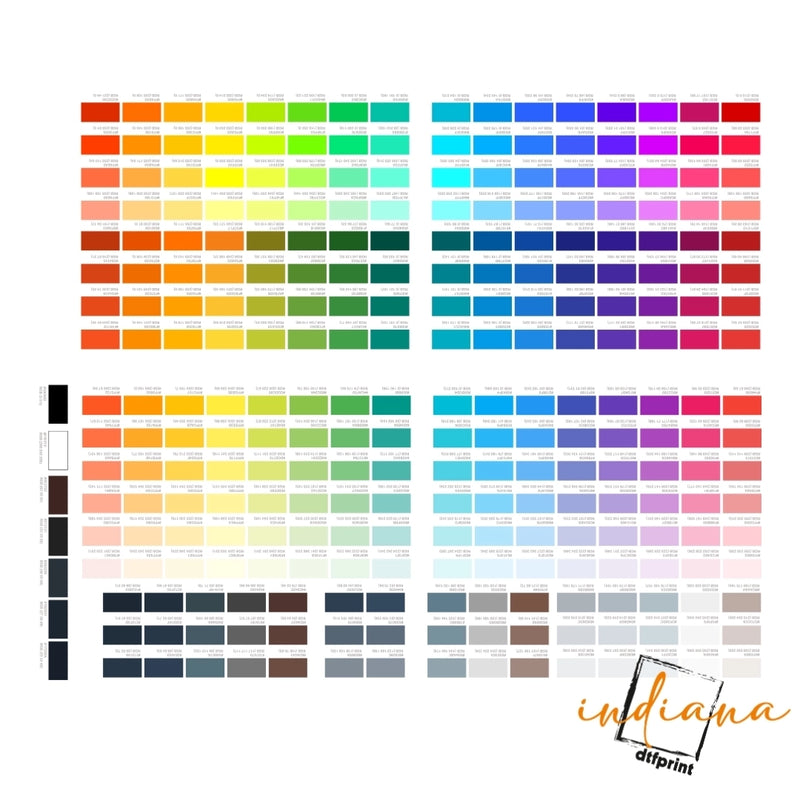Direct to Film (DTF) printing has revolutionized the garment printing industry by offering full-color, high-quality, and durable prints on a wide range of materials. But just because DTF works on “almost all fabrics” doesn’t mean all fabrics perform equally well.
If you want your custom apparel to stand out, feel great, and last long — choosing the right fabric for DTF transfers is just as important as using a high-quality printer or heat press.
In this guide, you’ll learn:
- Which fabrics work best for DTF
- Which ones to avoid or use with caution
- The right heat press settings for different materials
- Expert tips to ensure perfect transfers, every time
Why Fabric Matters in DTF Printing
The fabric you choose directly affects:
- Adhesion – How well the DTF transfer bonds with the material
- Color Output – The brightness and clarity of the design
- Comfort – How the print feels against the skin
- Washability – How well the print holds up after repeated washing
So even though DTF is versatile, choosing the best fabric ensures your customers love the look, feel, and longevity of your apparel.
Top 5 Best Fabrics for DTF Printing
1. 100% Cotton – The Gold Standard
Cotton is the most commonly used fabric for DTF printing, and for good reason.
Why It Works:
- Natural fibers allow for excellent ink absorption
- Soft, breathable, and comfortable for everyday wear
- Produces vibrant, high-resolution prints
Best Uses:
- T-shirts
- Baby clothes
- Fashion tops
- Promotional tees
Heat Press Settings:
- 150–160°C (302–320°F), 12–15 seconds, medium pressure
2. Cotton-Polyester Blends – The Best of Both Worlds
Blended fabrics (e.g., 60/40 or 50/50 cotton-poly) combine the softness of cotton with the durability and shape retention of polyester.
Why It Works:
- Less shrinkage than 100% cotton
- Great color vibrancy and long-lasting adhesion
- Feels soft and smooth
Best Uses:
- Hoodies
- Sweatshirts
- Joggers and gymwear
Heat Press Settings:
- 150°C, 10–12 seconds, medium pressure
3. 100% Polyester – Great for Activewear
Polyester can be tricky with some printing methods, but DTF handles it well — with a few adjustments.
Why It Works:
- Excellent for sportswear and quick-dry materials
- Doesn’t require special coatings like sublimation
- Transfers adhere well with proper temperature control
Things to Watch:
- Use lower heat to avoid scorching or melting
- Choose DTF films made for synthetics
Best Uses:
- Sports jerseys
- Performance t-shirts
- Uniforms
Heat Press Settings:
- 140–145°C (284–293°F), 8–10 seconds, light pressure
4. Fleece, Canvas, and Denim – Heavy but DTF-Friendly
DTF is surprisingly effective on thick and textured materials.
Why It Works:
- Adhesive powder bonds well with coarse fibers
- Allows for bold prints on outerwear and accessories
Best Uses:
- Jackets
- Canvas tote bags
- Denim shirts or jeans
- Fleece hoodies
Heat Press Settings:
- 160–170°C (320–338°F), 15–20 seconds, firm pressure
5. Rayon, Spandex, Lycra – Stretchy but Possible
Stretchy fabrics can be printed with DTF, but you need to take extra care.
Why It Works (With Caution):
- DTF can stretch slightly with the fabric if applied properly
- Requires low-temp film and light pressure
- Prints may crack if overstretched
Best Uses:
- Yoga wear
- Leggings
- Form-fitting tops
Heat Press Settings:
- 135–140°C, 8–10 seconds, light pressure
Fabrics to Avoid for DTF Transfers
While DTF is one of the most versatile print methods, a few materials should be avoided or tested carefully.
|
Fabric Type |
Reason to Avoid |
|
Silk |
Too delicate; heat damage likely |
|
Waterproof/Nylon Jackets |
May repel adhesive; uneven bonding |
|
Highly Textured Fabrics |
Ink may not fully adhere to raised surfaces |
|
Leather (faux or real) |
Can bubble or distort under heat |
Always test if you’re unsure about a new material.
Pro Tips for Choosing Fabrics for DTF
- Check Weave & Texture: Smooth, tightly woven fabrics deliver the best results.
- Use Pre-Washed Garments: This prevents shrinkage and ink distortion after printing.
- Mind the Stretch: Avoid over-stretching prints on fabrics like spandex.
- Keep Fabric Flat: Uneven or wrinkled surfaces will create patchy prints.
Want to Order DTF Transfers That Work on All Fabrics?
At IndianaDTFPrint.com, we specialize in:
- ✅ High-quality DTF transfers compatible with cotton, blends, polyester & more
- ✅ Custom gang sheets and bulk printing
- ✅ Fast shipping across USA
- ✅ Professional-grade films and eco-friendly inks
Whether you're starting a small t-shirt business or scaling your apparel brand, we help you print with confidence on any fabric.
Final Thoughts
Choosing the right fabric for DTF printing is essential to getting professional-quality results. While DTF gives you the freedom to print on nearly anything, some materials perform far better than others.
Top Choice: Cotton and cotton blends offer the best mix of print quality, comfort, and durability.
Avoid: Delicate, waterproof, or overly stretchy fabrics unless tested first.
If you're aiming for vibrant designs, long-lasting prints, and happy customers, start with the right fabric — and the right DTF supplier.











